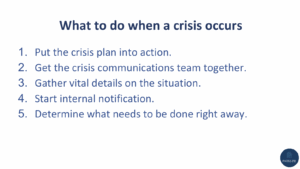As hurricane season intensifies in Pinellas County, nonprofit leaders gathered at the Lealman Exchange for the Q2 Impact Council meeting, hosted by the St Pete Catalyst. IC meetings provide a thinktank environment for freeform and guided discussion of the most timely and relevant topics in the nonprofit space.
The programmed piece of the meeting focused on crisis communications with featured speaker Kyle Parks. Parks, a veteran communications strategist, shared practical guidance drawn from his extensive experience working with universities, foundations, and other NPOs. The key message: Every organization needs a clear, tailored crisis communications plan that reflects its specific needs—not a generic template.
“A bad plan is too long and unclear,” Parks said. “A good plan gives you rules of the road, and clear actions specific to your organization.”
IC members contributing to the conversation included:
-
- Ava Cahoon (Boys & Girls Club Tampa Bay), Melissa Allen (Florida Holocaust Museum), and Sheryl Zeitler (St. Petersburg Free Clinic), each sharing insights into how crisis preparedness intersects with their direct service work.
- Chris Torello (Habitat for Humanity Gulfside), Jacqueline Roche and Duggan Cooley (Pinellas Community Foundation), Sam Jenkins (Institute for Strategic Policy Solutions), Becca McCoy and Keara McGraw (St. Petersburg Foundation), and Barbara Green (Foundation for a Healthy St. Petersburg) added depth from a broad range of community services.
- Joe Hamilton and Amy Cianci represented the St Pete Catalyst and the St. Petersburg Group, focusing on turning the meeting’s content into the next IC quarterly project.
Defining a Crisis
The conversation kicked off with a look at the many forms of crises —natural disasters, lawsuits, misinformation or viral social media posts. Each of these can threaten an organization’s ability to operate and serve its community. All of them have the common thread of being best handled in ways that demonstrate the care and credibility of the organization. It is clear that advance planning can be the difference between lasting harm and temporary pain.

Building a Crisis Team
A strong plan identifies a core response team, including executive leadership, communications, HR, and legal counsel. Training for these teams, along with broader staff education and practice runs, is essential.
Parks emphasized the value of media training and having designated spokespeople. Clear and concise messaging—tailored to different audiences such as staff, partners, and the media—helps build trust and mitigate confusion.
The plan should be robust, considering many different scenarios. For example, when traditional digital infrastructure fails, alternative communication tools, such as printed flyers, phone trees, or predetermined gathering points, should be in place. Participants shared experiences where physical spaces like the Lealman Exchange served as communications hubs when other systems were down.
Managing Public Perception and Misinformation
In today’s digital landscape, misinformation can spread rapidly. Impact Council members shared their strategies for maintaining a strong digital presence, managing reputation and responding authentically on social media. They also discussed how politically charged or DEI-related issues can escalate quickly and require thoughtful, values-driven responses.
Parks noted the importance of tone evolution—nonprofits must strike a balance between caution and clarity, and avoid silence that could be misinterpreted as indifference.

The Power of Collaboration
Council members underscored the importance of peer coordination. Proactive communication with partner organizations ensures unified messaging and avoids conflicting information during crises.
The meeting also addressed the need to communicate expectations to the public before a crisis occurs—setting a clear picture of what the community can expect from the organization both during and after the crisis.
Key Takeaways and Action Items
The session concluded with a list of practical next steps for nonprofits:
- Develop a tailored crisis communications plan.
- If you have a crisis communications plan, update it.
- Identify and train your internal crisis response team.
- Conduct media and messaging training.
- Coordinate with partner organizations in advance.
- Build alternative communications strategies for outages.
- Monitor and respond to misinformation proactively.
- A communications tree is critical – who will contact whom?
- Give your communications lead a seat at the planning table.
The Impact Council remains committed to supporting nonprofits in their efforts to build readiness, resilience, and trust.



